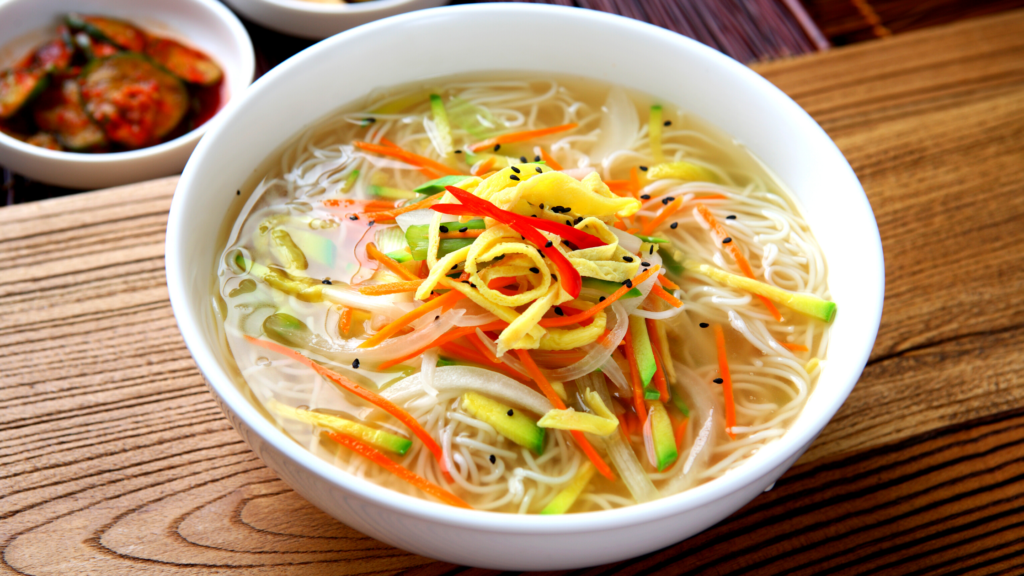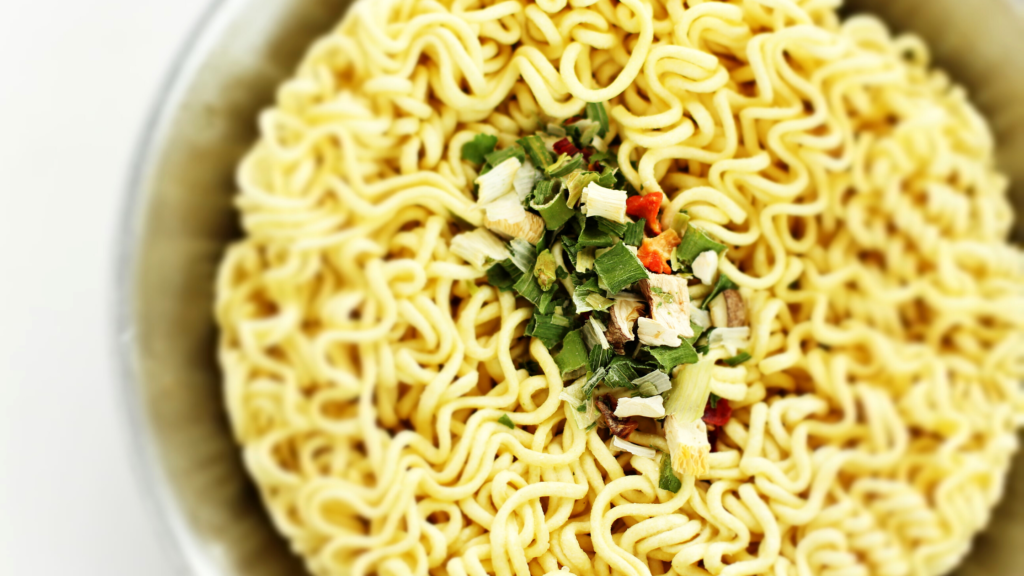It is no secret that Koreans love eating noodles. There is such a huge variety of noodle dishes: cold noodles, hot noodles, spicy noodles, black noodles, ramyeon, chewy noodles, and so on. Noodles are often eaten on special occasions, such as weddings and birthdays, but many people also order them to eat at home when they do not feel like cooking. And of course, ramyeon (the Korean word for ramen) is enjoyed any time of the day! Let’s have a look at some of most famous Korean noodles and ramen dishes.

Korean Noodle And Ramen Culture
Korean Noodle dishes are some of the most commonly eaten dishes in East Asia and date back to around 6000 to 5000 BC. In Korea, noodles are often called guksu (국수) or myeon (면). Guksu is the native Korean word for noodles, whilst myeon is the sino-Korean word.
Korean people believe that noodles symbolize longevity, which is why noodle dishes are often eaten during birthdays or weddings. People believe that eating a noodle dish symbolizes a long and healthy (marriage) life.
Although ramyeon is made of noodles as well, it is more often seen as a quick, easy, and simple meal and is not often eaten on special occasions. Ramyeon often comes in a cup – called cup ramyeon – and is prepared by simply adding boiling water to the cup. These instant noodles are often seen as a quick dish for students or working people after a long day, or eaten during hiking or a night out. Ramyeon is also used as a well-known pick-up line. If, after a date or a night out, you are asked to “eat some ramyeon before you go” (라면 먹고 갈래?), you are asked to stay the night and sleep over.
Famous Korean Noodle Dishes
Let’s have a look at some of the most famous Korean noodles (excluding ramyeon dishes, scroll down to have a look at those).
1. Janchi Guksu
Janchi Guksu (잔치국수) is a deceptively simple dish. It is made of wheat flour noodles in a light, hearty anchovy broth with some thinly sliced vegetables, seaweed, and egg. It is often served with a sauce made from sesame oil, soy sauce, and a little bit of chilli pepper and scallions.
Janchi Guksu literally means ‘banquet noodles’, as this dish is often eaten during parties, weddings, and 60th birthday parties. The noodles in Janchi Guksu are very long so they are believed to symbolize longevity in marriage. As Janchi Guksu is so often served at weddings, the phrase “when will you serve os Janchi Guksu?” is a way of asking when you are going to get married. Sometimes, the wedding day is also referred to as “a day to eat guksu”.

2. Kalguksu
Kalguksu (칼국수) are knife-cut noodles, hence the name! Kal (칼) is the Korean word for knife, as these noodles are cut instead of pulled. The Kalguksu noodles are served in a light broth made of anchovies, shellfish, and kelp. It is often garnished with vegetables such as zucchini, potato, and scallions. Kalguksu is often considered a seasonal food, as it is mostly consumed during the summer. You can easily find restaurants that sell these kind of noodles, especially in traditional markets like Namdaemun Market. Of all the Korean noodle dishes, this is by far the most famous Korean noodles.
3. Jjamppong
If you like spicy food, Jjamppong (짬뽕) is the perfect noodle dish for you. Jjamppong is a famous Korean noodles soup that is based on Chinese cuisine and thus often served at Chinese restaurants in Korea, together with Jajangmyeon. Jjamppong is made using a spicy seafood (or sometimes pork) broth with a lot of gochugaru (Korean red chilli) powder. Jjamppong often includes ingredients like onions, garlic, zucchini, carrots, cabbages, squid, mussels, and pork. It is definitely one of the most popular Korean noodles among Koreans.
4. Bibim Guksu
Bibim Guksu (비빔국수), which literally means mixed noodles, is a cold, spicy noodle dish that is very popular during summer. It is made from thin wheat noodles called somyeon. The dish is characterized by a very strong, spicy flavor from the combination of red pepper powder, gochujang (red pepper paste), and minced garlic, and the sweet-sour taste derived from vinegar and sugar. Bibimguksu often contains toppings such as julienned cucumbers, hard-boiled eggs, dried seaweed, and pickled radish. The combination of the spicy flavor with the cold chewy noodles makes it a perfect summer dish.
5. Naengmyeon
Another cold noodle dish, Naengmyeon (냉면) is made from chewy buckwheat or sweet potato noodles. There are two main varieties. Mul Naengmyeon (물 냉면) is served as a cold noodle soup with a beef or chicken broth. Bibim Naengmyeon (비빔 냉면) is, like Bibim Guksu, served in a spicy sauce. Often, a bowl of broth is served on the side to accompany the Bibim Naengmyeon.
Naengmyeon, and especially Mul Naengmyeon, originated from North Korea. Called Pyeongyang Naengmyeon is made from buckwheat noodles and beef broth, with some sliced radish added to the dish. You can eat Pyeongyang Naengmyeon in many North Korean restaurants in Seoul.
6. Kongguksu
Kongguksu (콩국수) are wheat noodles served in a cold soybean soup. Kong (콩) is the Korean word for soybean. The ‘broth’ is made from soybean milk and often contains actual ice cubes floating around in it. The soup is a lot thicker than most other noodle soups and has a very unique texture. This filling dish is most often eaten during summer.
Famous Korean Instant Ramen
Before we go into the most famous Korean ramyeon brands, let’s get one thing out of the way: ramyeon, ramyun, or ramen? Generally, ramen refers to the Japanese dish, whereas ramyeon and ramyun both refer to the Korean dish. It just depends on how the Korean (라면) is transcribed to English.
Most famous ramyeon brands have cup ramyeon as well as packaged ramyeon. When eating cup ramyeon, you simply open the cup, pour the contents of the flavor packet on top of the noodles, and cover it with boiling water. Close the lid, and after 3~4 minutes you can enjoy a nice hot cup of ramyeon. Packaged ramyeon should be boiled in a pot, and you can add all kinds of ingredients to the soup if you like, such as eggs, cheese, or scallions.

1. Samyang Ramyeon
Released in 1963, Samyang Ramyeon (삼양 라면) is a mild ramyeon that is not very spicy. This is one of the oldest ramyeon on the market and many Koreans like it for its traditional and nostalgic taste. As it is very basic, it tastes very good when you add an egg or some cheese to it.
2. Nongshim Shin Ramyeon
Probably the most famous ramyeon in Korea and abroad, Nongshim Shin Ramyeong (농심 신라면) is a staple in many households. It is quite spicy, especially if you are not used to Korean spice, and contains small chunks of beef and flakes of vegetables. There is the basic red option and a premium black option, which comes with a packet of seolleongtang soup to make the soup even heartier.
3. Samyang Buldak Bokkeum Myeon
Samyang Buldak Bokkeum Myeon (삼양불닭볶음면) is so incredibly spicy that it led to a YouTube challenge: the Korean Fire Noodle Challenge. Many people, in Korea and abroad, tried to eat one whole package of the fiery spicy Buldak Bokkeum Myeon. It is not a soup-based ramyeon, as the water is drained after the noodles are boiled. What remains is a volcano-like sauce that is sure to make you sweat. Besides the regular spicy option, there is also a super spicy one for the real daredevils.
4. Ottoogi Sesame Ramyeon
Another great, non-spicy ramyeon option: Ottoogi Sesame Ramyeon (오뚜기 참깨라면). The broth is based on sesame and egg and is very hearty and warming. As it is not spicy, there are many people who prefer to eat this ramyeon. It is especially nice when an egg and some cheese are added to it.
5. Jin Jjajang Ramyeon
Jjajangmyeon are noodles covered in a sweet, hearty black bean sauce. Jin Jjajang (진짜장) Ramyeon combines that delicious black bean sauce with ramyeon noodles. It can easily be made at home or in a convenience store. Like Buldak Bokkeum Myeon, the water needs to be drained after the noodles have softened to create the jjajang sauce.
6. Jjapaguri Noodles (Famous Parasite Noodles)
If you have watched the movie Parasite, you have probably wondered what those noodles they were eating were. Called Jjapaguri (짜파구리) in the movie (ram-don in English), it is technically a combination of two instant noodles: Jjapaghetti (짜파게티) and Neoguri (너구리). Jjapaghetti is an instant version of Jjajangmyeon (but with thinner noodles), whilst Neoguri is an udon dish that comes with a spicy, kelp-based broth.
How to make it? Basically, you add the noodles from both packets to boiling water until they are soft. Drain the water, but leave around 6 tablespoons. Then, add the whole packet of Jjapaghetti powder soup sauce, 1/3 packet of Neoguri powder soup sauce, and olive oil from the Jjapaghetti sauce. If you like spicy food, add some more Neoguri powder. Mix well and serve! In Parasite, they added some steak to the dish as well. Simply cut the steak into small pieces, cook them until desired, and add them at the end.
What’s your favorite famous Korean noodles? Although not introduced above, there are many more noodles on the market and waiting for you. How about enjoying Korean noodle dishes today? Enjoy!

Comments are closed.